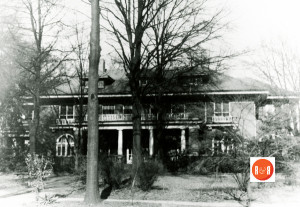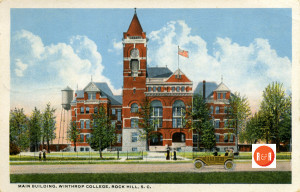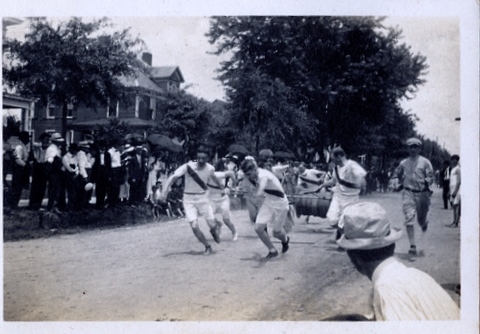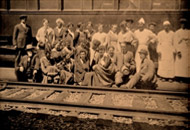Oakland Avenue was a major urban development project in the late 19th century, used to connect downtown Rock Hill’s commercial district, with the newly established women’s college, now Winthrop University. To learn more about Oakland’s development as a business venture by several of Rock Hill’s leading citizens, click on Oakland’s Development, for further details.

W.J. Roddey home in the early 1950s. Image courtesy of the WU Pettus Archives – Eliz. Reed Collection – 1950s.
The tour of Oakland Avenue does not include every home or business, rather a number of significant structures located along the stretch of the tree lined street, from the Overhead Bridge to Winthrop University. Oakland Avenue was truly Rock Hill’s finest early 20th century address. The street was lined with substantial homes constructed in numerous architectural styles and dominated by beautiful homes. It seems each subsequent owner tried to impress the passerby-er as well as their new neighbors. Collectively the residents of Oakland Avenue comprised some of South Carolina’s leading bankers, entrepreneurs, educators, doctors, and hydroelectric engineers.
The Record reported on Oct. 16, 1911 – “Mayor J.T. Roddey, say the new concrete bridge proposed for Oakland Ave., has been approved by the regional office of the Southern Railroad and the proposal will now go to the national office.”
Oakland’s Tour is offered as a means of learning about individuals who shaped, not only the street, but their love of architecture and turn of the century aspirations.
The Rock Hill Record reported on April 22, 1904 – “That Jim Deal, one of the Southern Railroad tres).”
HISTORIC TOUR OF OAKLAND AVENUE
1) One of the lovely homes along Oakland which was demolished for an auto dealership was the Stevens – Willis house. (Demolished – Legal Remedy)
2) Across the street from the Willis home was the Roddey – Patrick house which was moved to this location.
3) Next to the Roddey – Patrick house stood the extraordinary home of the William J. Roddey family. (Demolished – Northeastern corner of Oakland and Wilson)
4) On the opposite corner, the location of the bank building, once stood the fine Whitner House. (Demolished – Bank)
5) One of the true business development leaders of Rock Hill was James Milton Cherry whose home was an early site on Oakland Avenue. (Demolished – Northwest corner of Oakland and Wilson)
6) The Queen Anne home of John Gary Anderson remains one of Rock Hill’s defining pieces of architecture. (227 Oakland Avenue)
7) The Calhoun Home at 242 Oakland Avenue remains one of it’s smallest dwellings but architecturally intact.
8) Following the death of her husband, Mrs. Rosa G. Strait constructed this home at 326 Oakland Avenue and resided there until 1969.
9) Demolished in the name of progress, the Dunlap House once was one of Oakland’s showplaces.

Image courtesy of the Turner Postcard Collection – 2012
10) One of Oakland’s grand Neo-Classical homes is the Stokes – Mayfield house, constructed in the early 20th century.
11) Right of the Mayfield home, was the Barron House (361 Oakland Ave.), later moved to College Avenue and converted into apartments.
12) Across the street in the middle of the block is the handsome John G. Barron home at 348 Oakland Avenue.
13) One the corner of Oakland and Union Streets, across from the Nationwide Office, once stood the Fewell – Poe Home. (Demolished)
14) Next to Oakland Avenue Presbyterian Church once stood the impressive Edward Fewell home at 419 Oakland Avenue. (Demolished)
15) Individual who had once attended First Pres. in downtown helped establish Oakland Avenue Presbyterian Church.
16) The Grace Lutheran Church was an expensive piece of church architecture and remains one of Oakland’s architectural treasures.
17) The handsome Wilson – Joslin – Jeter – Baer home at 505 Oakland Ave., remains one of the lovely residential dwellings on the street.
18) The former Cinema Theater once was the location of the Mauldin’s Home on Oakland Avenue prior to their moving to Aiken Avenue.
19) The Winthrop Un. President’s Home was originally the private residence of W.H. Stewart a successful contractor, who sold his home for use as the new residence of the college’s President at 601 Oakland Avenue.
20) Another A.D. Holler was was constructed at 636 Oakland Ave., for the Rev. Holler, the contractor’s son.
21) A collection of images depicting Winthrop University’s history.
22) Winthrop Training School, better known as WTS, served thousands of students from all walks of life in Rock Hill’s diverse communities for decades.
Stay Connected
Explore history, houses, and stories across S.C. Your membership provides you with updates on regional topics, information on historic research, preservation, and monthly feature articles. But remember R&R wants to hear from you and assist in preserving your own family genealogy and memorabilia.
Visit the Southern Queries – Forum to receive assistance in answering questions, discuss genealogy, and enjoy exploring preservation topics with other members. Also listed are several history and genealogical researchers for hire.
User comments welcome — post at the bottom of this page.
Please enjoy this structure and all those listed in Roots and Recall. But remember each is private property. So view them from a distance or from a public area such as the sidewalk or public road.
Do you have information to share and preserve? Family, school, church, or other older photos and stories are welcome. Send them digitally through the “Share Your Story” link, so they too might be posted on Roots and Recall.
Thanks!
User comments always welcome - please post at the bottom of this page.




Do you have any information on the Wintrhop College Farm around 1925-1935?